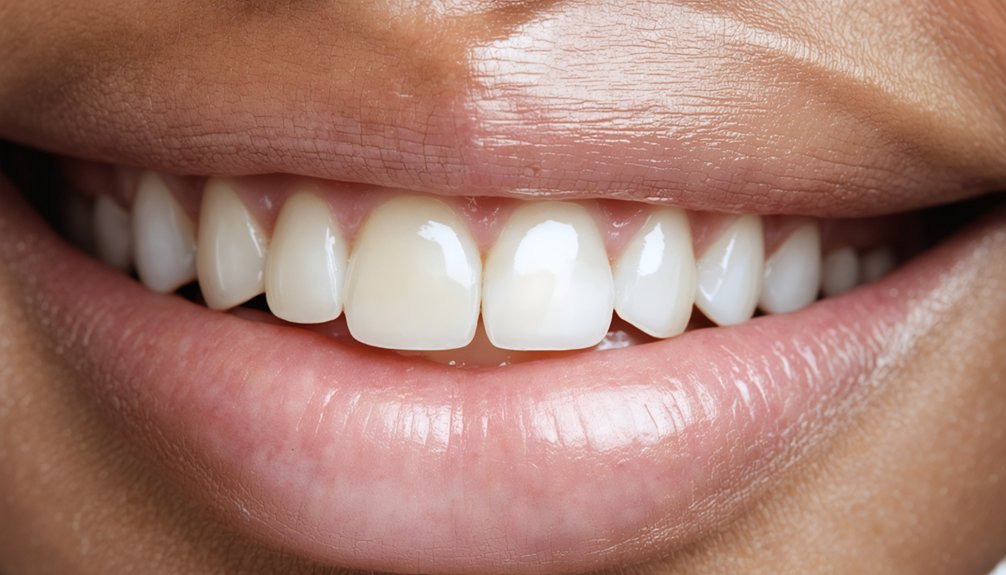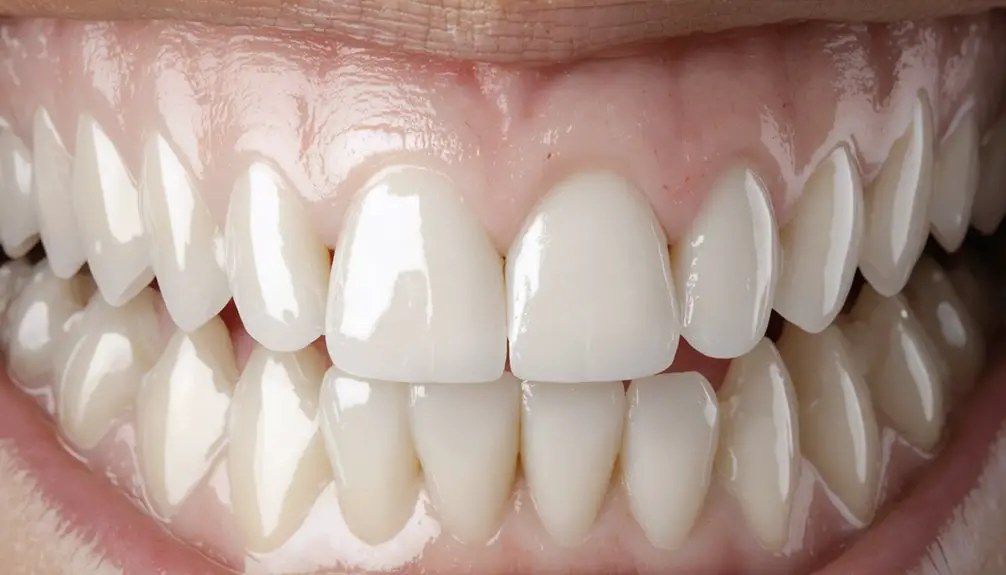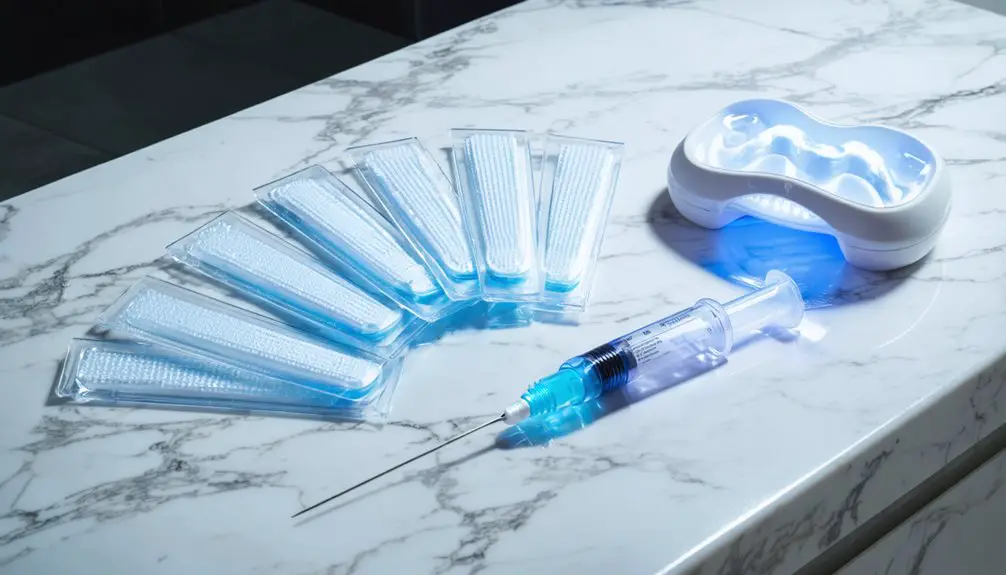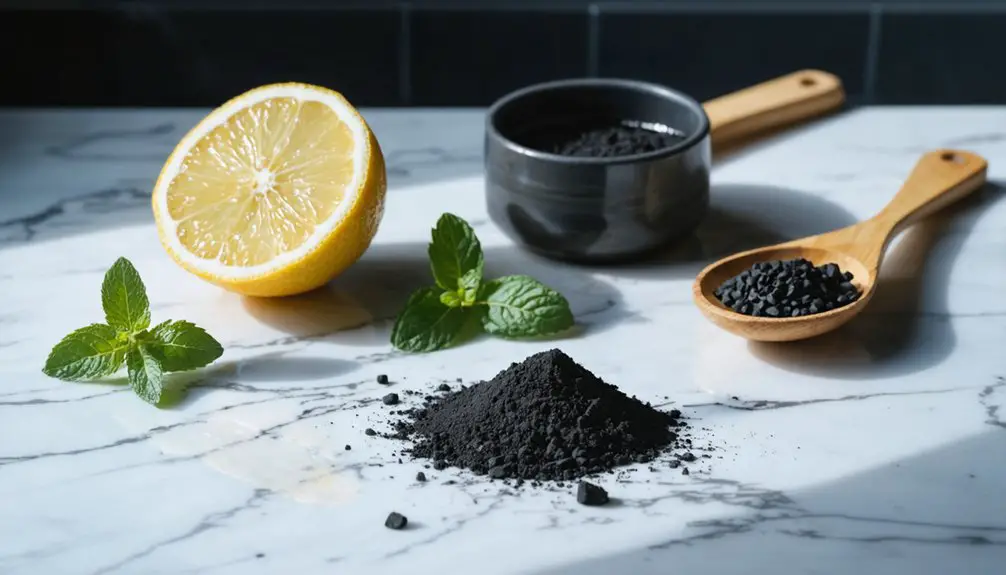Natural-looking teeth whitening becomes possible when you work with your tooth’s natural characteristics while protecting the enamel. Your teeth’s unique color comes from the interplay between translucent enamel and underlying dentin, which requires gentle whitening agents like hydrogen peroxide or enzyme-based solutions to achieve uniform results. You’ll get the most natural appearance by combining proper whitening techniques with enamel-protecting measures and consistent oral care. Understanding these elements will help you achieve that perfect balance of brightness and authenticity.
Key Takeaways
- Strong, healthy enamel enables uniform whitening results by providing a stable foundation for bleaching agents to work effectively.
- Understanding natural tooth color variations helps achieve realistic whitening goals that complement individual genetic characteristics.
- Professional-grade whitening agents at appropriate concentrations ensure gradual, even results while protecting enamel integrity.
- Consistent enamel protection through proper oral hygiene and remineralization techniques supports lasting, natural-looking whiteness.
- Regular maintenance combining diet management, lifestyle adjustments, and periodic touch-ups maintains authentic whitening results.
Understanding the Science Behind Natural Tooth Color
The intricacy of natural tooth color stems primarily from genetic inheritance, which determines your baseline tooth shade and enamel characteristics.
Your teeth’s appearance results from the interplay between genetic factors that control enamel thickness and the yellowish dentin color beneath it.
Understanding tooth shade involves recognizing both intrinsic stains, which affect internal tooth structure, and extrinsic staining from environmental factors like diet and lifestyle.
Your enamel’s translucent nature allows dentin’s color to show through, creating unique optical properties that influence overall color perception.
The thickness and mineral composition of your enamel, also genetically determined, affect how much of dentin’s natural yellow tone is visible.
This complex interaction creates your distinct tooth shade, which professional whitening treatments must consider for natural-looking results. Ethnic backgrounds can also influence natural tooth coloration due to genetic variations passed down through ancestral lines.
Once tooth development is complete, your body cannot produce new enamel structure, making protection of existing enamel crucial for maintaining natural color.
Safe and Effective Natural Whitening Agents
When seeking natural alternatives for teeth whitening, several proven agents offer effective results without compromising enamel health. You’ll find hydrogen peroxide stands out as the most effective natural agent, particularly when combined with baking soda for enhanced stain removal and safety. Both work synergistically to lift discoloration while protecting your enamel.
For gentler techniques, consider enzyme-based options like papain and bromelain, which break down protein stains without causing surface alterations. These natural agents are especially suitable if you have sensitive teeth or prefer avoiding peroxide. Professional treatments may be necessary for dramatic lasting results.
You can complement these whitening methods with coconut oil pulling, which helps prevent new stains while supporting overall oral health. The antimicrobial lauric acid in coconut oil helps eliminate harmful bacteria that contribute to staining. Remember to maintain consistent oral hygiene practices to maximize the effectiveness of these natural whitening techniques.
The Role of Enamel Protection in Whitening
Your enamel’s strength is essential for achieving natural-looking whitening results, so you’ll need to protect it from daily wear through proper brushing techniques and avoiding acidic foods.
You can maintain ideal mineral balance by using fluoride treatments and calcium-rich products, which help strengthen your enamel’s protective abilities. Carbamide peroxide treatments are effective while being gentler on tooth enamel compared to other whitening agents.
Professional whitening methods that respect your enamel’s integrity will give you the best results while preserving your teeth’s natural defense system. Thicker enamel provides more uniform whitening results and better stain resistance for a more natural appearance.
Preventing Enamel Wear Daily
Maintaining healthy tooth enamel plays an essential role in achieving natural-looking white teeth that last. To protect your enamel daily, you’ll need to minimize exposure to acidic foods and beverages. When you do consume acidic items, drink them quickly rather than sipping, use a straw, and rinse with water afterward. Adding citrus fruits to less acidic foods can help reduce their erosive effects on teeth.
Focus on gentle, enamel restoration techniques by using daily fluoride toothpaste designed for protection rather than harsh whitening products. Professional whitening treatments that use peroxide-based compounds are more effective than DIY methods. Avoid abrasive substances like activated charcoal or DIY whitening pastes that can wear down your enamel.
Instead, practice consistent oral hygiene with careful brushing and regular flossing to prevent stain-causing plaque buildup. Remember not to brush immediately after consuming acidic foods or beverages, as this can damage temporarily softened enamel.
Mineral Balance For Strength
Strong enamel protection serves as the foundation for successful teeth whitening and lasting results.
You’ll achieve ideal outcomes by focusing on enamel remineralization techniques during and after whitening treatments. Fluoride application benefits include strengthening your enamel’s mineral content while reducing sensitivity that often occurs during whitening procedures.
The crystalline calcium phosphate structure of tooth enamel makes it particularly receptive to remineralization efforts when properly supported. Saliva production stimulation plays a vital role in naturally rebuilding and protecting your enamel’s mineral content.
When you maintain proper mineral balance, your enamel becomes more resistant to staining and responds better to whitening agents.
Professional supervision guarantees your enamel’s thickness can support treatment safely, while custom trays prevent overexposure to bleaching compounds.
You’ll want to incorporate fluoride treatments into your post-whitening care routine to restore minerals that may be affected during the process. This approach helps protect enamel integrity while supporting long-term whitening success through enhanced mineral stability.
Safe Whitening Methods Work
Effective whitening treatments depend on preserving enamel integrity throughout the process.
You’ll achieve the best results by following professional guidelines for whitening frequency and using proper application techniques. Low-concentration peroxide treatments administered through custom-fitted trays offer controlled dosing that protects your enamel while delivering consistent results.
Avoid harsh DIY methods like baking soda scrubs or acidic fruit mixtures that can permanently damage enamel.
Instead, opt for non-abrasive whitening toothpastes with gentle polishing agents. If you’re considering professional treatments, higher concentration office-based procedures often provide safer outcomes due to precise application protocols and proper activation methods.
Balancing Whitening Results With Tooth Health
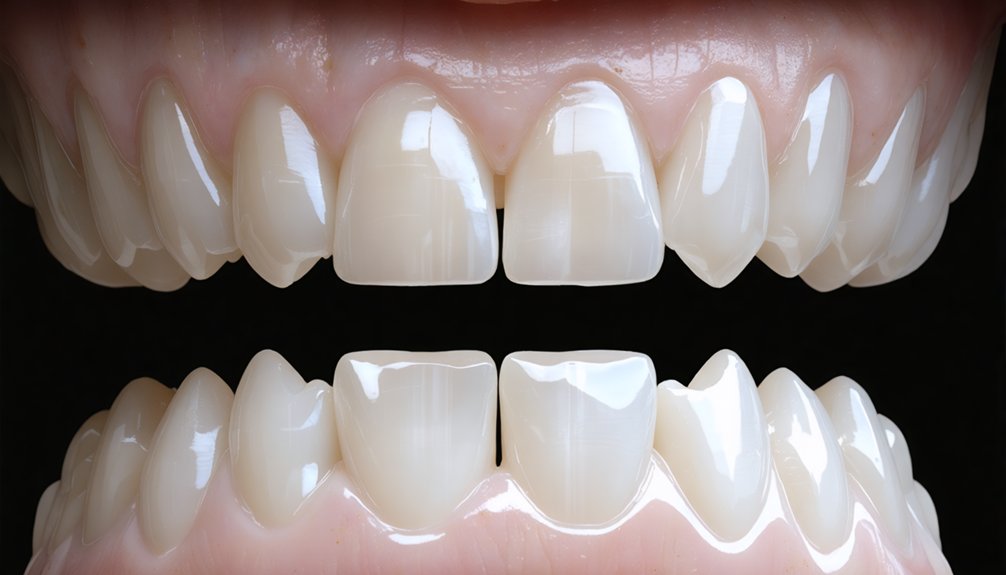
When pursuing whiter teeth, finding the right balance between aesthetic results and oral health becomes crucial. A professional whitening consultation helps create a personalized approach that considers your unique oral health status and sensitivity risks.
Your dentist can determine safe peroxide concentrations while implementing sensitivity management strategies. Lower peroxide concentrations around 10% can effectively whiten teeth while minimizing side effects.
Professional supervision guarantees controlled procedures that protect your oral microbiome and enamel integrity. Modern options like hydroxyapatite-based treatments offer gentle whitening by repairing micro-defects without oxidative damage.
They’re particularly beneficial if you have sensitive teeth or compromised enamel.
Diet and Lifestyle Choices for Whiter Teeth
Maintaining your teeth’s whiteness largely depends on the dietary choices you make each day. While some research questions the impact of dietary restrictions post-whitening, it’s wise to avoid highly pigmented foods and beverages like coffee, red wine, and dark berries that can stain your enamel.
Instead, focus on whitening foods that naturally support tooth brightness, such as fiber-rich apples, celery, and dairy products rich in calcium and phosphorus.
For best results, especially in the 24-48 hours after treatment, stick to a “white diet” featuring neutral-colored foods like chicken, cauliflower, and plain yogurt.
Remember to drink water after consuming staining substances, as it helps rinse away pigment particles. Combined with proper oral hygiene, these dietary choices will help preserve your whitening results longer.
Professional vs. DIY Whitening Methods Compared
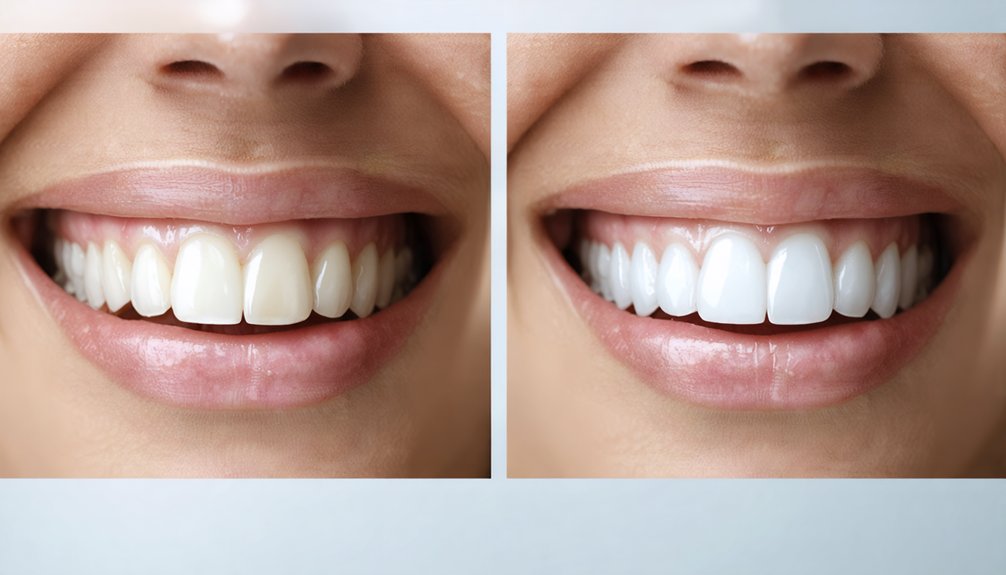
Beyond dietary choices, selecting the right whitening method greatly impacts your results.
Professional whitening techniques deliver faster, more dramatic results—up to 8 shades lighter in just 1-2 hours—under careful dental supervision. You’ll benefit from higher-grade bleaching agents and customized treatment protocols that protect your teeth and gums.
While DIY options offer lower treatment costs and convenience, their limitations are significant.
Over-the-counter products use diluted formulas that work more slowly and may not address stubborn stains. Without professional oversight, you risk uneven results, sensitivity, or enamel damage from improper use.
Though initially cheaper, DIY methods might require professional intervention later if problems arise. For safe, efficient, and natural-looking results, professional whitening provides the most reliable path to a brighter smile.
Preventing Damage During the Whitening Process
To protect your teeth during whitening treatments, following proper safety protocols is crucial. Start by choosing whitening products with lower hydrogen peroxide concentrations (under 10%) and make sure they’re labeled as low-sensitivity.
You’ll need custom-fitted trays to prevent gum exposure and uneven application of bleaching agents.
Before starting any whitening regime, address existing dental issues and have your enamel condition evaluated by a professional. These whitening precautions help prevent complications and heightened sensitivity.
For maximum enamel protection, use products containing potassium nitrate or particulate hydroxyapatite, and allow sufficient rest periods between sessions.
Never mix household substances like lemon juice with baking soda, as these create harmful acidic mixtures that permanently damage tooth structure. Instead, follow manufacturer instructions precisely and maintain excellent oral hygiene throughout your whitening process.
Long-Term Maintenance of Natural White Teeth
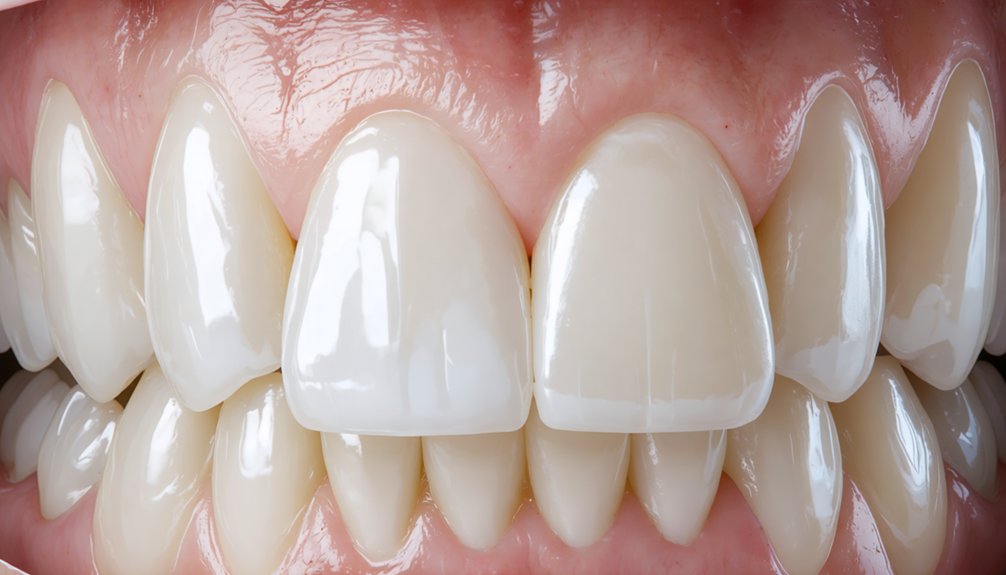
Your daily habits play an essential role in maintaining naturally white teeth, from consistent brushing and flossing to being mindful of staining foods and beverages.
You’ll need to establish a routine that includes proper oral hygiene practices, regular dental check-ups, and the occasional use of dentist-approved whitening products to preserve your results.
Making smart dietary choices, such as limiting coffee and red wine while increasing water intake, will help protect your investment in a brighter smile.
Daily Habits That Matter
Maintaining naturally white teeth requires consistent daily habits that go far beyond occasional whitening treatments. Your daily brushing and flossing routine creates the foundation for a naturally bright smile, while strategic dietary choices help prevent staining and discoloration.
- Practice thorough oral hygiene twice daily using fluoride-based whitening toothpaste, followed by flossing to remove debris between teeth and rinsing with a whitening mouthwash.
- Choose teeth-friendly foods and beverages, incorporating crunchy fruits and vegetables that naturally clean teeth while limiting coffee, tea, and red wine consumption.
- Stay well-hydrated and rinse with water after meals or dark beverages, using a straw when possible to minimize contact between staining liquids and your front teeth.
Preventive Care Essentials
While daily habits form the foundation of a bright smile, long-term maintenance of naturally white teeth requires a thorough preventive care strategy.
Regular preventive check-ups enable your dentist to detect and address issues that could affect tooth color before they worsen. Professional cleanings remove stubborn plaque and surface stains that home care might miss.
Your oral health directly impacts the longevity of whitening results. You’ll need to minimize exposure to staining agents by limiting coffee, tea, and red wine consumption.
When you do consume these beverages, use a straw and rinse afterward. Tobacco use greatly compromises whitening efforts, so if you smoke, quitting will help maintain your results.
Consider periodic touch-up treatments, whether through professional services or dentist-prescribed home maintenance protocols, to preserve your natural-looking white smile.
Essential Oral Care Habits for Lasting Results
To preserve the results of teeth whitening treatments, adopting proper oral care habits is essential for long-term success. Your daily brushing frequency should include two thorough sessions using a soft-bristled toothbrush and gentle whitening toothpaste.
Master proper flossing techniques to remove plaque between teeth, which helps prevent discoloration and maintains brightness.
- Brush twice daily with a non-abrasive whitening toothpaste, replacing your toothbrush every three months to guarantee effective cleaning.
- Floss daily to eliminate stubborn plaque and food particles that can lead to staining between teeth.
- Rinse your mouth thoroughly with water after consuming staining beverages or foods, and use a straw when possible to minimize contact with your teeth.
Remember to schedule regular dental cleanings every six months to maintain professional oversight of your whitening results.
Frequently Asked Questions
How Soon After Whitening Teeth Can I Safely Get Pregnant?
You can try to conceive immediately after teeth whitening since peroxide treatments don’t affect fertility. However, for ideal whitening safety and pregnancy timing, you’ll want to complete whitening before conception.
Can Whitening Treatments Affect Existing Dental Work Like Crowns or Veneers?
Your existing crowns and veneers won’t respond to whitening treatments due to dental material compatibility. While you won’t experience whitening sensitivity in these restorations, they’ll maintain their original shade regardless of bleaching.
Does Swimming in Chlorinated Pools Affect Tooth Whitening Results?
Like acid rain on marble, chlorine exposure from pools can erode your enamel and create stains that impact whitening results. Poor pool maintenance heightens these risks to your smile’s brightness.
Are There Specific Toothpaste Ingredients That Can Neutralize Whitening Effects?
High-alkaline ingredients like baking soda in your toothpaste can neutralize peroxide-based whitening agents. While fluoride and desensitizing agents won’t affect whitening effectiveness, excessive abrasives might impact enamel surface integrity.
Do Medications Taken After Whitening Influence the Longevity of Results?
Yes, certain medication types can affect your whitening duration. Antibiotics like tetracycline and minocycline, along with chlorhexidine, antihypertensives, and antihistamines, may reduce the longevity of your whitening results.
References
- https://www.healthline.com/nutrition/whiten-teeth-naturally
- https://www.thetopekadentistry.com/blog/natural-teeth-whitening-methods-work/47541
- https://www.smile101.com/natural-vs-professional-teeth-whitening-whats-the-difference/
- https://www.urmc.rochester.edu/news/publications/health-matters/diy-teeth-whitening-too-good-to-be-true
- https://pmc.ncbi.nlm.nih.gov/articles/PMC4058574/
- https://www.ada.org/resources/ada-library/oral-health-topics/whitening
- https://www.mouthhealthy.org/all-topics-a-z/natural-teeth-whitening
- https://pubmed.ncbi.nlm.nih.gov/36942206/
- https://onestopdentalcolorado.com/the-role-of-genetics-in-tooth-color/
- https://yourcommunitydental.com/chemistry-behind-teeth-staining/
